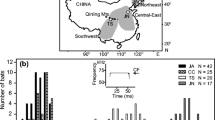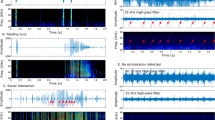Abstract
The literature suggests that in familiar laboratory settings, Indian false vampire bats (Megaderma lyra, family Megadermatidae) locate terrestrial prey with and without emitting echolocation calls in the dark and cease echolocating when simulated moonlit conditions presumably allow the use of vision. More recent laboratory-based research suggests that M. lyra uses echolocation throughout attacks but at emission rates much lower than those of other gleaning bats. We present data from wild-caught bats hunting for and capturing prey in unfamiliar conditions mimicking natural situations. By varying light level and substrate complexity we demonstrated that hunting M. lyra always emit echolocation calls and that emission patterns are the same regardless of light/substrate condition and similar to those of other wild-caught gleaning bats. Therefore, echoic information appears necessary for this species when hunting in unfamiliar situations, while, in the context of past research, echolocation may be supplanted by vision, spatial memory or both in familiar spaces.



Similar content being viewed by others
References
Arlettaz R, Jones G, Racey PA (2001) Effect of acoustic clutter on prey detection by bats. Nature 414:742–745
Audet D, Krull D, Marimuthu G, Sumithran S, Balasingh J (1991) Foraging behavior of the Indian false vampire bat, Megaderma lyra (Chiroptera: Megadermatidae). Biotropica 23:63–67
Bailey WJ, Haythornthwaite S (1998) Risks of calling by the field cricket Teleogryllus oceanicus: potential predation by Australian long-eared bats. J Zool 244:505–513
Barber JR, Razak RA, Fuzessery ZM (2003) Can two streams of auditory information be processed simultaneously? Evidence from the gleaning bat Antrozous pallidus. J Comp Physiol A 189:843–855
Bell GP (1985) The sensory basis for prey selection by the Californian leaf-nosed bat, Macrotus californicus. Behav Ecol Sociobiol 16:343–347
Bell GP, Fenton MB (1986) Visual acuity, sensitivity and binocularity in a gleaning insectivorous bat, Macrotus californicus (Chiroptera: Phyllostomidae). Anim Behav 34:409–414
Bregman AS (1990) Auditory scene analysis: the perceptual organization of sound. MIT Press, Cambridge
Dusenbery DB (1992) Sensory ecology: how organisms acquire and respond to information. Freeman, New York
Eklof J, Jones G (2003) Use of vision in prey detection by brown long-eared bats Plecotus auritus. Anim Behav 66:949–953
Fast SJ, Ambrose HW (1976) Prey preference and hunting habitat selection in the barn owl. Am Midl Nat 96:503–507
Fenton MB, Gaudet CL, Leonard ML (1983) Feeding behaviour of the bats Nycteris grandis and Nycteris thebaica (Nycetridae) in captivity. J Zool 200:347–354
Fiedler J (1979) Prey catching with and without echolocation in the Indian false vampire (Megaderma lyra). Behav Ecol Sociobiol 6:155–160
Gallistel CR (1990) The organization of learning. MIT Press, Cambridge, Mass.
Grant JDA (1991) Prey location by two Australian long-eared bats, Nyctophilus gouldi and N. geoffroyi. Aust J Zool 39:45–56
Griffin DR, Webster FA, Michael CR (1960) The echolocation of flying insects by bats. Anim Behav 8:141–154
Jones G, Webb PI, Sedgeley JA, O’Donnell CFJ (2003) Mysterious Mystacina: how the New Zealand short-tailed bat (Mystacina tuberculata) locates insect prey. J Exp Biol 206:4209–4216
Kalko EKV, Schnitzler H-U (1989) The echolocation and hunting behavior of Daubenton’s bat, Myotis daubentoni. Behav Ecol Sociobiol 24:225–238
Konishi M (1983) Neuroethology of acoustic prey localization in the barn owl. In: Huber F, Markl H (eds) Neuroethology and behavioral physiology. Springer, Berlin Heidelberg New York, pp 303–317
Leippert D, Frank E, Gabriel P, Kutter P, Scheidemann KD (2002) Prey-correlated spectral changes in echolocation sounds of the Indian false vampire Megaderma lyra. Ethology 108:139–156
Marimuthu G, Neuweiler G (1987) The use of acoustical cues for prey detection by the Indian false vampire bat, Megaderma lyra. J Comp Physiol A 160:509–515
Marimuthu G, Habersetzer J, Leippert D (1995) Active acoustic gleaning from the water surface by the Indian false vampire bat, Megaderma lyra. Ethology 99:61–74
Neuweiler G (1989) Foraging ecology and audition in echolocating bats. Trends Ecol Evol 4:160–166
Neuweiler G, Möhres FP (1967) The role of spatial memory in the orientation. In: Busnel RG (ed) Les systèmes sonars animaux. Louis-Jean Ouvrages scientifiques, Gap, pp 129–140
Neuweiler G, Singh S, Sripathi K (1984) Audiograms of a south Indian bat community. J Comp Physiol A 154:133–142
Ratcliffe JM, Dawson JW (2003) Behavioural flexibility: the little brown bat, Myotis lucifugus, and the northern long-eared bat, M. septentrionalis, both glean and hawk prey. Anim Behav 66:847–856
Rice WR (1989) Analyzing tables of statistical tests. Evolution 43:223–225
Schmidt S, Türke B, Vogler B (1984) Behavioural audiogram from the bat, Megaderma lyra. Myotis 22:62–66
Schmidt S, Hanke S, Pillat J (2000) The role of echolocation in the hunting of terrestrial prey—evidence for an underestimated strategy in the gleaning bat, Megaderma lyra. J Comp Physiol A 186:975–988
Schnitzler H-U, Moss CF, Denzinger A (2003) From spatial orientation to food acquisition in echolocating bats. Trends Ecol Evol 18:386–394
Siemers BM, Schnitzler H-U (2004) Echolocation signals reflect niche differentiation in five sympatric congeneric bat species. Nature 429:657–661
Siemers BM, Kalko EKV, Schnitzler H-U (2001) Echolocation and signal plasticity in the Neotropical bat Myotis nigricans (Schinz, 1821) (Vespertilioniidae): a convergent case with European species of Pipistrellus? Behav Ecol Sociobiol 50:317–328
Speakman JR, Racey PA (1991) No cost of echolocation for bats in flight. Nature 350:421–423
Springer MS, Stanhope MJ, Madsen O, de Jong WW (2004) Molecules consolidate the placental mammal tree. Trends Ecol Evol 19:430–438
Stamps J (1995) Motor learning and the value of familiar space. Am Nat 146:41–58
Stoneman MG, Fenton MB (1988) Disrupting foraging bats: the clicks of arctiid moths. In: Nachtigall PE, Moore PWB (eds) Animal sonar: processes and performance. Plenum, New York, pp 635–638
Surlykke A, Moss CF (2000) Echolocation behavior of big brown bats, Eptesicus fuscus, in the field and laboratory. J Acoust Soc Am 108:2419–2429
Teeling EC, Madsen O, Van Den Bussche RA, de Jong WW, Stanhope MJ, Springer MS (2002) Microbat paraphyly and the convergent evolution of a key innovation in Old World rhinolophoid microbats. Proc Natl Acad Sci 99:1431–1436
Tuttle MD, Ryan MJ (1981) Bat predation and the evolution of frog vocalizations in the Neotropics. Science 214:677–678
Willigen RF van der, Frost BJ, Wagner H (2003) How owls structure visual information. Anim Cogn 6:39–55
Zar JH (1996) Biostatistical analysis, 3rd edn. Prentice-Hall, Upper Saddle River, N.J.
Acknowledgements
P. Abrams, J. Barber, H. ter Hofstede, A. McGuigan, B. Neff and S. Shettleworth and three anonymous reviewers provided comments and criticisms that improved upon earlier versions of the manuscript. This study was financed through a Journal of Experimental Biology traveling fellowship and a Natural Sciences and Engineering Council of Canada (NSERC) post-graduate fellowship to J. Ratcliffe, NSERC grants to B. Fenton and J. Fullard and grants from the Department of Science and Technology of India to G. Marimuthu. Capture, holding, and experimental procedures used in this study were approved by the Institutional Ethical and Bio-safety Committee of MKU and the Forestry Department, Government of India and complied with the current laws of India.
Author information
Authors and Affiliations
Corresponding author
Additional information
Communicated by T. Czeschlik
Rights and permissions
About this article
Cite this article
Ratcliffe, J.M., Raghuram, H., Marimuthu, G. et al. Hunting in unfamiliar space: echolocation in the Indian false vampire bat, Megaderma lyra, when gleaning prey. Behav Ecol Sociobiol 58, 157–164 (2005). https://doi.org/10.1007/s00265-005-0912-z
Received:
Revised:
Accepted:
Published:
Issue Date:
DOI: https://doi.org/10.1007/s00265-005-0912-z




